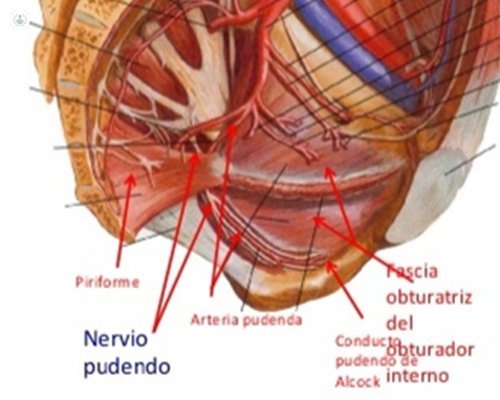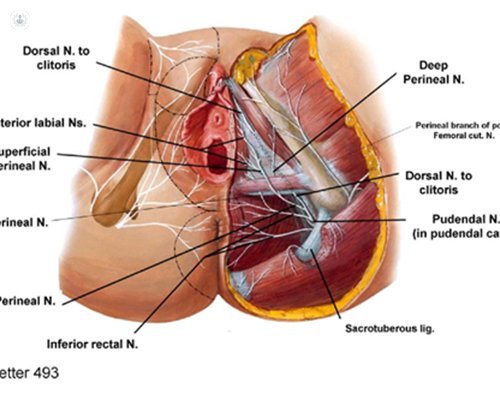Areas that may be affected by Pudenda Neuralgia
Written by:The pudendal nerve along its route passes through different defiles, described as possible points of pudendal nerve entrapment.
- The clamp formed between the sacrospinous ligaments and sacrotuberous (70% of cases studied entrapment are located in this area).
- Alcock channel (20% of cases).
- Sickle cell process sacro-tuberous ligament.
- Anywhere along the path of the pudendal nerve or its branches.

Diagnosis of Pudenda Neuralgia
The diagnosis of Pudenda Neuralgia is mostly from symptoms. Imaging tests (Rx, MRI, CT, ultrasound) can only be indicated to rule out other pathology.
The electromyogram (EMG) can be helpful, but is not always conclusive.
What can we do in the unit with the pudendal neuralgia pain?
Most patients attending the consultation of specialist Pain Unit have already taken various medications like analgesics / anti - inflammatories, muscle relaxants or medication for neuropathic pain, as Amitryptilina (Tryptizol), pregabalin (Lyrica), gabapentin (Neurontin) without get improvement.

Treatment of Neuralgia Pudenda
I will not describe the surgical treatment, because it is not my specialty, but may be another alternative in cases that do not improve with conservative techniques. The problem that most patients find with surgery is that there are not many specialists dedicated to this pathology.
One of the recommended treatments is all guides physiotherapy or rehabilitation of pelvic floor. There units and centers specializing in this type of physical therapy that usually help.
In those cases not improve with this treatment, the unit initially conducted anesthetic blocks pain pudendal nerve. This treatment is simple; usually annoying but not painful and in many cases the pain usually improves for months. When pain returns can be repeated without any problem.
In cases that improvement with anesthetic blocks is not lasting, pulsed radiofrequency pudendal nerves is performed. This treatment is done in the operating room on an outpatient basis under local anesthesia and sedation if necessary patient (those who need it by anxiety or nervousness). It is made with the aid of ultrasound or x-rays to locate the nerves and involves the application of a type of high frequency current (RF) for 6 minutes decreases irritability and nerve pain often improves significantly. It is not a definitive treatment and may require repeated after several months or years.

In those most difficult and have not improved with no pretreatment cases, the next step that arises is the implantation of electrodes sacral stimulation.
Sacral electrodes are also implanted in the operating room with sedation and local anesthesia. It is done in two phases: an initial test in which the patient has electrodes over a period of 2-4 weeks and if no improvement is obtained, then the implant need a battery, generator or battery (like a pacemaker) that is the power to administer pain relief. This treatment often has a high degree of efficiency in difficult cases.


